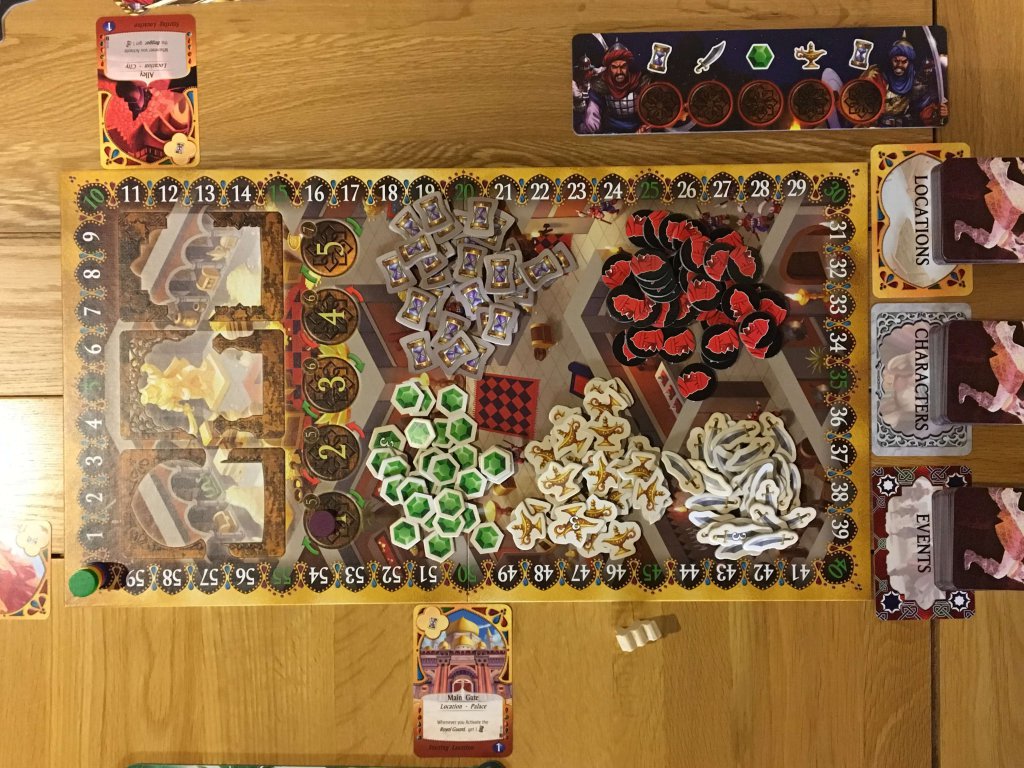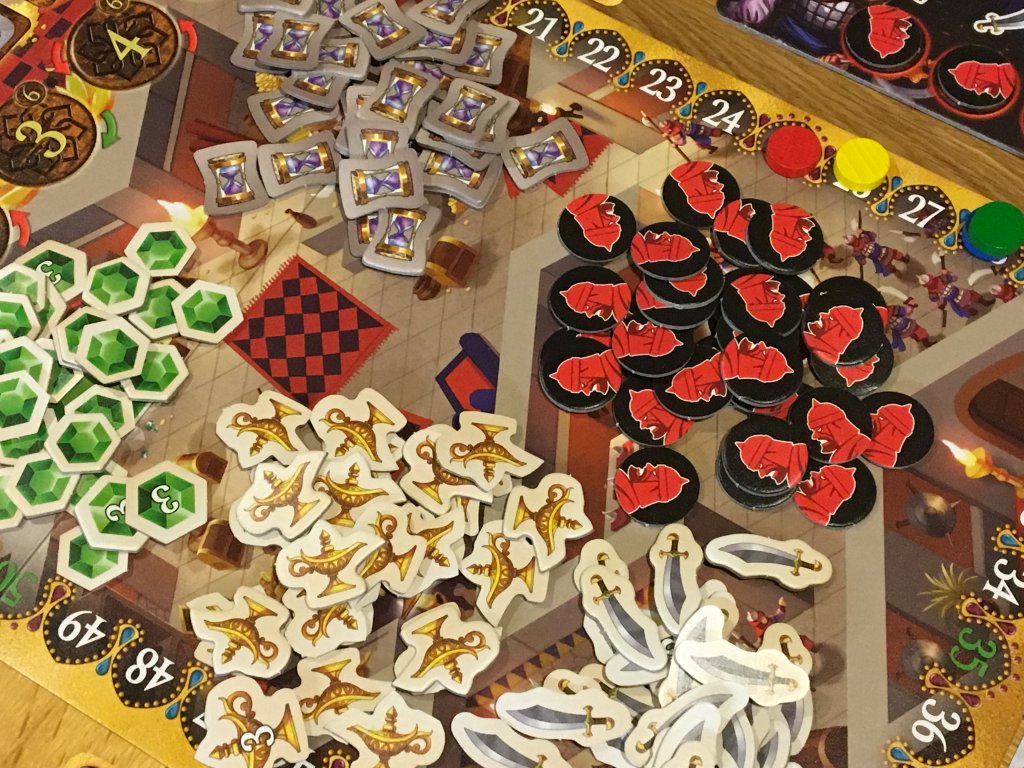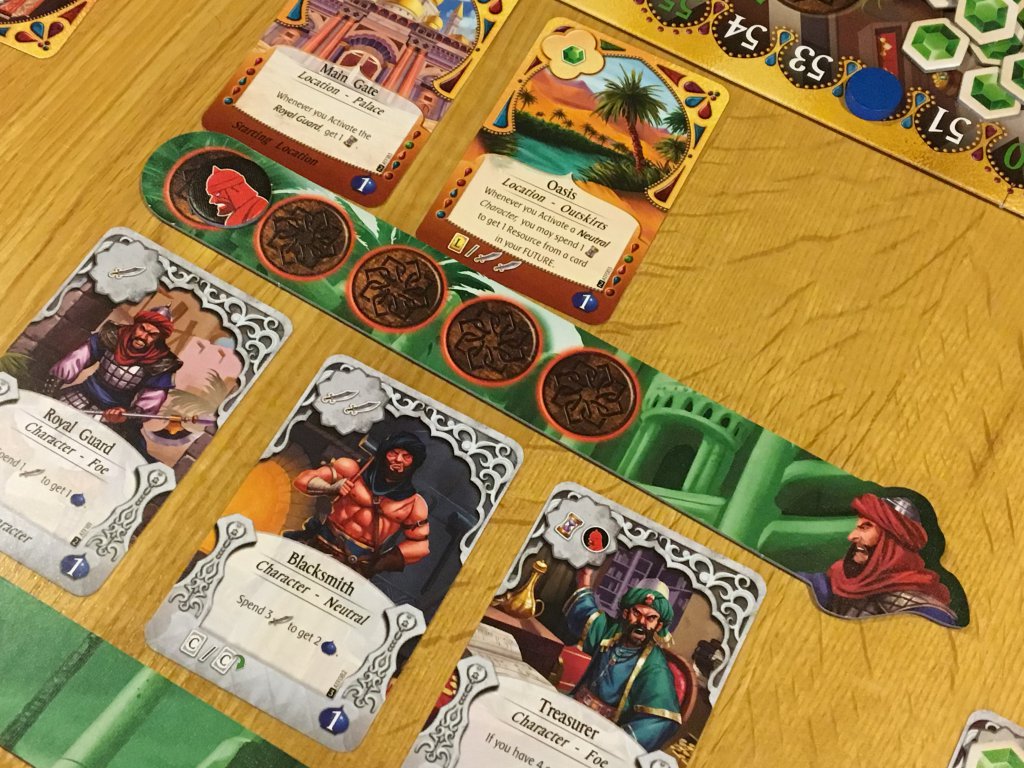In Artipia Games’ A Thief’s Fortune, the players each take responsibility for a different, alternative timeline, belonging to the same unfortunate individual. With thematic links to Prince of Persia: The Sands of Time, A Thief’s Fortune is likely to appeal to video and board gamers alike.
If the name of A Thief’s Fortune seems familiar, then that’s likely because we previously previewed it back in August last year. Since then, A Thief’s Fortune has been successfully delivered to backers and is now available in retail. Our review is focused on the retail version, but one or two of the components pictured are exclusive to Kickstarter copies (the item pouches, for example) so please bear that in mind.
Whilst some readers may recall the concept of A Thief’s Fortune from our preview, it’s probably worth a quick refresher to bring everyone up to speed. The objective of the game is to create the most favourable outcome for the thief by collecting fortune points, which are tracked like victory points are in the majority of games.
In order to score these points, players will collect Location, Event and Character cards that will be played into their timeline. Cards can occupy three different locations — the past, present and future. Cards are initially placed in the future with a number of resources on them as indicated. Once these resources are exhausted, cards in the future move into the present.
Whenever a card enters the present, it will bump any other cards leftwards — with a limit of four cards in the present at any time, this means the leftmost card can often be pushed out. When this happens, such cards go directly to a face up pile representing the past and there are numerous cards that provide fortune points if they end up here.
Gameplay in A Thief’s Fortune is split into four phases, beginning with the planning phase. During this phase, the players draw one card from each of the Location, Event and Character decks and then two more from any deck(s) of their choice. They then choose one and place it in their future (with the resources on it as shown) and pass two cards of their choosing to their neighbour.
The draft continues like this with players taking one card and passing two until each player only has two cards in hand (the two passed to them.) At this point, the players each choose one more card from this pair and play it to their future, then they discard the other, taking the favour shown on it as a bonus.
The next phase, Loot, is an interesting one that is uniquely hard to describe. This is the phase where players take resources from the cards in their future — with a limit based on the current turn. On the first turn, each player can take any five resources, which includes danger tokens that move directly to their Danger Track and resources that move to their stash. Like so many things in board games, it feels odd that taking resources from these things kind of “makes them happen” but then again, when you’re messing with the space-time continuum, who knows?
With this done, the players move on to the Action phase, which is where most of the interesting stuff happens. Players may choose one or two actions to perform, including activating characters and events for their listed ability or spend time, which involves trading two time tokens for any one resource from a card in the future (which may result in it moving to the present if no resources remain.) Players can continue to take turns, taking one or two actions until everyone has passed, with the first player passing becomes the first player in the next round.
Before I go on discussing the next phase, I should note that whilst the Action phase might sound mechanically straightforward, it’s actually where a lot of A Thief’s Fortune’s more interesting engine building mechanics come into play. You might activate a Character card who gives you a bonus that amplifies the effect of the Event that you then trigger for your second action, and between the two, you’re cumulatively able to pull several resources from the future, causing those cards to enter the present and provide further effects.
After actions, the player must pay resources in the Bribe phase based on how many Danger tokens they have. Each Danger token requires one basic resource to be discarded and any player who cannot pay must lose one fortune point per Danger token, which can make this phase quite punitive for those who fail to plan effectively. After this, the new first player takes the first player marker and all players reset any activated characters (which are turned sideways when used.)
After five rounds of performing card drafts and action rounds, the players will total any fortune points provided by the cards in their past and add that total to their score on the board. They will then add one further point for every five basic resources they have remaining — the player who has the most overall will be the winner.
When played, A Thief’s Fortune is like an ever changing engine building game, which is both its greatest strength and its biggest weakness. There are rounds in this game where players will almost stand up and take a bow, thanks to how wonderfully the cards that they have drafted and engineered into their timeline come together. Equally, some players (especially novices) can have a complete washout from time to time.
This is largely because there are several gaming skill sets needed to bring the best outcomes to bear. Firstly, a bit of luck is needed — you’ll have to draw cards that are at least somewhat favourable. I’d say that A Thief’s Fortune does this well by forcing one card of each kind into play, but then by allowing players to affect their own destiny by choosing two from any stack.
Next, there is drafting, which in isolation can cause a bit of analysis paralysis. In A Thief’s Fortune, the draft particularly favours experienced players since they’ll know instinctively what cards do what and which ones they need. Again, thankfully, Artipia Games has a solution for this via the very clear, generally straightforward iconography and rules text.
Finally, there is the management of cards from the future into the present and what that means for the cards already there. It’s relatively simple to assess several cards in the future and sequence them into your timeline at around the same time, but it’s harder to keep in mind what is already there and how those cards will be affected (ie disappear) as new cards enter. This, when assessed whilst drafting new cards, does definitely cause A Thief’s Fortune to slow down during later rounds.
With those purely observational points on the table, personally, I love playing A Thief’s Fortune. These complicated, impactful decisions are exactly what I want from my games and I don’t mind delays whilst players think about meaningful choices. This is helped because mechanically, A Thief’s Fortune is super simple — sure, there’s a lot on the table and the sequence of decisions is tough, but the actual phases of the game? Super simple.
Thanks to the superb components (which are bright, well made and very inclusive) and the fresh take on drafting and engine building, A Thief’s Fortune is a game that I want to play again and again. The decks of cards are very large, making repetition a lesser problem than it might have been, whilst the overall game length (about an hour) feels perfect given that it is possible for players to fall behind.
A Thief’s Fortune is a unique and attractive proposition, and it is definitely a game that anyone should consider adding to their collection if they are in the market for a drafting game with a fresh theme and a lot of interesting and unusual ideas.
A Thief’s Fortune is available for purchase now. You can find out more about it here.
Love board games? Check out our list of the top board games we’ve reviewed.






